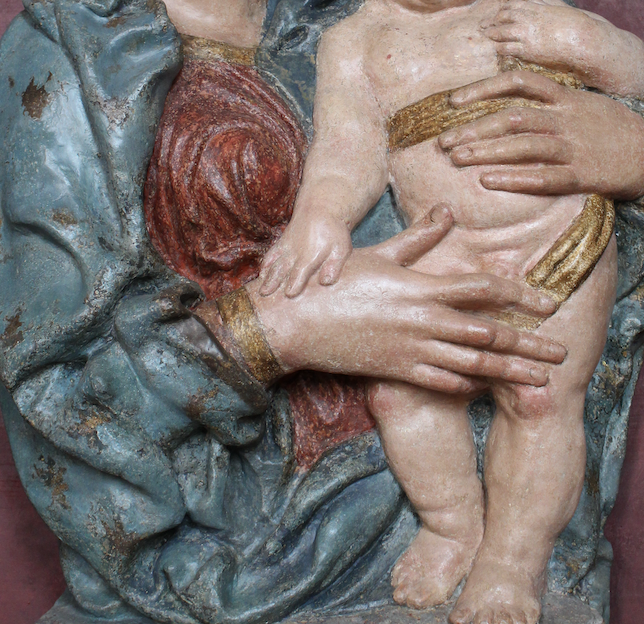Decoration for an Organ by Neroccio di Bartolomeo de’ Landi
Madonna and Child (Madonna del Latte) by an unknown artist
Today we think of plaster as the building material used to coat walls and ceilings. Yet, the classical medium dates back to ancient Greece and Rome and was revived in the Renaissance. Made from a concoction of ground-up limestone, wax, and milk, it was used for festival decorations, architectural ornaments, and primer underneath painting. Sculptures were quick to make by pouring wet plaster into a mould of an original. Once set, it was durable. Many copies were made from the same mould. Each sculpture would be individually painted, breathing life into the forms. For example, these plaster images were from the same mould, but look different. The left image is fully coloured, while the right is painted white and selectively gilded.
Even cheaper was papier-mâché. Bits of paper, trash and cloth mixed with glue and starch would be hand-pressed into a mould. Papier-mâché is lighter, cheaper and less durable than plaster, and was not considered classical.
Madonna and Child, Decoration for an Organ, and Madonna del Latte demonstrate the range of possibilities within the medium. Plaster was used as a decorative ornament on furniture, architecture and for independent sculpture. Papier-mâché was also a material that made sculptures and decorations. Although these two Madonna’s are the same type of object with similar artistic techniques, the difference between the more durable, polished plaster and the fragile, rougher papier-mâché is clear.
Plaster and papier-mâché were associated with mechanical reproduction and ornaments for the home rather than grand public commissions. These mediums show a cheaper side of the Renaissance.



Click the links below to learn more about the materials and techniques of these objects:
Madonna and Child by the Workshop of Jacopo della Quercia. Photo: Una D’Elia (L)
Decoration for an Organ by Neroccio di Bartolomeo de’ Landi. Photo: Una D’Elia. (Centre)
Madonna and Child (Madonna del Latte) by an Unknown Artist. Photo: Una D’Elia. (R)
Bibliography: Cennini, Cennino. The Craftsman’s Handbook. Trans. Daniel V. Thompson, Jr. New York: Dover, 1960; Vasari, Giorgio. Vasari on Technique. Trans. Louisa Maclehose. New York: Dover, 1960; Penny, Nicholas. The Materials of Sculpture. New Haven & London: Yale University Press, 1993; Gapper, Claire. “What is Stucco? English Interpretations of an Italian Term.” Architectural History 42 (1999), pp. 333-343. DOI 70.53.64.109; Marchand, Eckhard. “Material Distinctions: Plaster, Terracotta, and Wax in the Renaissance Artist’s Workshop,” in The Matter of Art: Materials, Practices, Cultural Logics, c. 1250-1750, ed. Christy Anderson, Anne Dunlop, and Pamela H. Smith (Manchester: Manchester University Press, 2015), 160-79; “Madonna and Child,” “Decoration for an Organ,” and “Madonna and Child (Madonna del Latte),” Renaissance Polychrome Sculpture in Tuscany, https://qspace.library.queensu.ca/handle/1974/14832 (accessed 20 November 2019).





